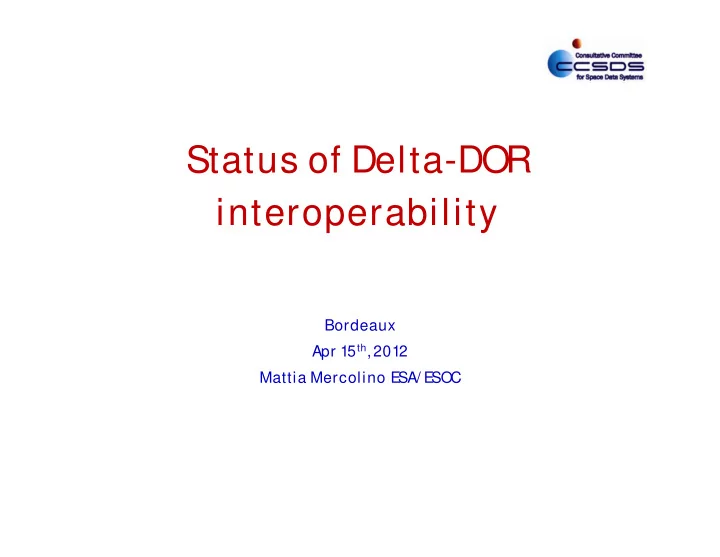

Status of Delta-DOR interoperability Bordeaux Apr 15 th , 2012 Mattia Mercolino E SA/ E SOC
Summary Validation of ESA enhanced Wideband DOR Validation of RDEF format Validation of low SNR development Ka-band Quasar catalogue Full interoperability validation
SA wideband DOR E All 3 ESA DS antennas are equipped with wide-band DDOR wiring (latest being MLG, tested from June 2012 on) Functional tests of wideband implementation was carried out during Spring/Summer 2012 Final test with flying S/C with DOR tones executed on JUNO (Sept 2013) Validation with JPL: Data correlated by ESA/JPL in the frame of the RDEF validation Results in line with theoretical sigma calculations End-to-end validation (including OD) still pending Needed in the frame of In-Sight preparation Validation with JAXA: still pending (needed in the frame of BepiColombo cross-support)
RDE F interface (1) RDEF format has been implemented at both data translator and correlator level The current implementation of the data translator / correlator provides all possible translation combinations VLBI MK-V ESA DSN RDEF Correlator RDEF Translator ESA EOLP JPL VSR NASA DSN
RDE F interface (2) Final RDEF implementation was integrated in the upgraded ESA translator/correlator S/W Concerning the validation of the RDEF format, Validation with JPL: JUNO data have been used to this purpose. The exercise showed no issues between JPL implementation and ESA S/W. Validation with JAXA: still pending (needed for the BepiColombo cross-support) Validation with BITTT: initiated (on VEX data translated to RDEF and provided to BITTT) in the frame of the Chang’E3 Delta-DOR support. No data received so far from BITTT. No end-to-end exercise completed to date.
Low SNR Last enhancement of the ESA DDOR correlator regards the capability to process data at very low SNR (i.e. 1 dBHz) Such capability has first been implemented and tested with simulated data in February 2012 Final test was performed on VEX data, which were artificially manipulated in order to add “thermal-like” noise and lower down the signal-to-noise density ratio on the S/C signal. Test demonstrated that current ESA implementation agrees with theoretical expectations given the signal-to-noise density ratio level and the integration time used Test/Use with actual data may be planned with Hayabusa TBC with JAXA
Ka-band Quasar survey [1] Following the meeting in Boulder, a roadmap was set together with C. Jacobs to target a Ka-band quasar observation campaign from Malargüe, in late 2012, early 2013 An IA and a dedicated TAA were signed between NASA/ESA First set of test was organised, involving Robledo and Canberra antennas on JPL side and Cebreros on ESA side, in July 2012. After validation of set-up the PRSR (JPL receiver) has been shipped to ESA DS-3 (Malargüe) and installed there in November. First tests executed in December 2012 with detection of fringes in Ka-band More tests (including 12-h long runs) were performed in January/February Latest tests performed on 12/13 th of April (data still to be processed)
Ka-band Quasar survey [2] 8400 km 9900 km 10,600 km 8500 km 9810 km ESA DS-3 adds 3 baseline to the current JPL configuration, allowing for full southern sky coverage Almost perpendicular baselines between W-E and N-S directions
Ka-band Quasar survey [3] Tests with MLG allowed the addition of 95 new sources in Ka-band to date Accuracy can be improved only by further observations The continuation of the activity needs a formal request by JPL
Full interoperability validation [1] In order to have a full interoperability validation between ESA and any other Agency, the following has to be addressed I/F validation Validation of RDEF format Validation of TDM (for processed DDOR and meteo data) Validation of OEM (for orbit predication data) Functional validation Validation of wideband DDOR (necessary to support S/C with DOR tone according CCSDS 401-B) Validation of low SNR (in case S/C with weak signal have to be supported) End-to-end validation Validation of OD solutions obtained with interoperability exercise
Full interoperability validation [2] Validation with JPL I/F validation Validation of RDEF format OK (on JUNO) Validation of TDM OK (several instances, also new TDM) Validation of OEM OK (several instances) Functional validation Validation of wideband DDOR OK (on JUNO) Validation of low SNR Not exercised yet End-to-end validation Validation of OD solutions OK (for narrowband DDOR) Validation of OD solutions Not done yet (for wideband DDOR) Priority: exercise end-to-end validation of wideband DDOR (for In-Sight)
Full interoperability validation [3] Validation with JAXA I/F validation Validation of RDEF format Not exercised yet Validation of TDM OK (TBC) Validation of OEM OK Functional validation Validation of wideband DDOR Not exercised yet Validation of low SNR Not exercised yet End-to-end validation Validation of OD solutions Not done yet (for narrowband DDOR) Validation of OD solutions Not done yet (for wideband DDOR) Priority: validate RDEF, end-to-end narrow-band DDOR and end-to-end of wideband DDOR (for BepiColombo)
Full interoperability validation [4] Validation with BITTT I/F validation Validation of RDEF format On-going Validation of TDM On-going Validation of OEM OK Functional validation Validation of wideband DDOR Not exercised yet Validation of low SNR Not exercised yet End-to-end validation Validation of OD solutions Not done yet (for narrowband DDOR) Validation of OD solutions Not done yet (for wideband DDOR) Priority: validate RDEF, end-to-end narrow-band DDOR and end-to-end of wideband DDOR (for Chang’E3)
Recommend
More recommend